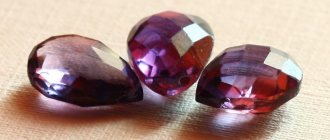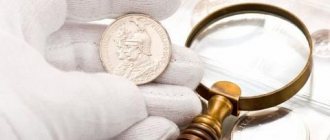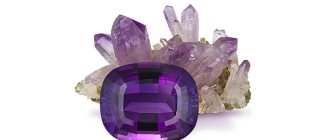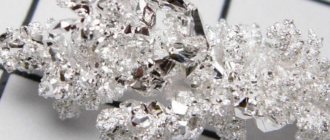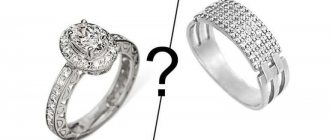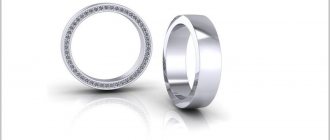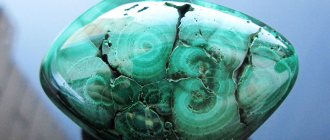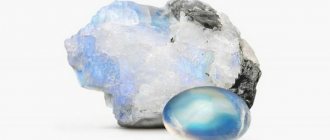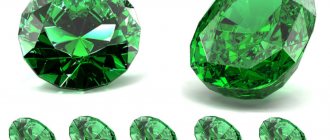Alexandrite is known for its unique ability to change its color from emerald green to burgundy red depending on the type of lighting. The history of this mineral is as unusual as its properties.
According to the officially accepted version, the gem was first discovered in 1833 in the Ural emerald mines and presented to the general public in April 1834 on the day of the coming of age of the future Russian sovereign Alexander II. In honor of the Tsarevich, the stone received such a beautiful name.
Already, as emperor, Alexander 2 wore, without removing, a ring with alexandrite as a personal talisman, thanks to which this Ural gem also began to be called the “imperial stone”.
Alexandrite also enjoyed special respect among the Soviet authorities. Jewelry containing it was prohibited for sale, and the fate of each individual stone was carefully monitored.
Today, alexandrite is considered one of the rarest and most beautiful gemstones. Some of its pieces are valued at more than diamonds.
Types and colors of alexandrite
Alexandrite is a type of chrysoberyl. Its chemical composition is unique. In addition to iron and titanium, this stone contains chromium, the ions of which cause an impressive change in color, called color reversal by gemologists. In some cases, the process of color change is also influenced by the vanadium contained in the mineral.
Alexandrite is transparent, but very rarely colorless. Its most common color is bluish-green. Less common is olive with shades of yellow and brown.
Stones mined from different deposits may differ significantly in color palette. Ural alexandrite, which is rightly considered the standard of beauty, has a bluish-green color in daylight, and crimson or purple-red in artificial light.
Gems from Africa or Brazil are colored brownish-greenish during the day, and under artificial lighting they can become several tones redder than Ural stone. Alexandrite from the island of Sri Lanka under the bright rays of the sun resembles the color of Ural minerals, and in the evening light it turns purple.
In terms of depth of color reverse, Ural alexandrites are the leaders.
Deposits, stone mining
The Ural emerald mines are considered to be the primary deposit of alexandrite. Currently, their reserves are practically depleted, and stone mining is not being carried out.
A deposit of fairly large crystals was discovered in the 80s of the last century in Brazil, but this mine was completely mined within three months, after which finds of the precious stone became sporadic.
Today, Sri Lanka is considered the largest supplier of alexandrite to the world market. The mineral is also mined in Thailand, India, Tanzania and Madagascar. Experts admit that none of the stones mined at these deposits can compare with the absolute beauty of the Ural gem. Back to contents
A rare mineral comparable in value to a diamond
Alexandrite is a type of chrysoberyl and one of the five most expensive stones . In Russia, stone mining has been stopped due to depletion of deposits .
Previously, the crystal was mined in the Urals. It was the favorite gem of Alexander II. It was in his honor that the gem was named. During the Soviet era, it was declared the property of the republic and a ban was introduced on its sale within the country. All mined minerals were sold abroad to replenish the treasury with foreign currency.
The cost of precious stones is usually calculated in American dollars, and their weight is calculated in carats. There are special publications that contain tables with stones and their recommended prices.
How much does alexandrite stone cost (natural and artificial)
The price of alexandrites depends on their color, depth of color reverse (Alexandrite effect), degree of purity and weight. Among the most expensive are Ural gems that have a greenish tint. A flawless mineral mined in the Ural deposits can be more expensive than diamonds. The best examples of alexandrite are valued at between $20,000 and $35,000 per carat.
It is important to know that natural alexandrite is a very small stone, and therefore the faceted insert rarely exceeds the weight of one carat. However, if such a stone does occur, its cost, according to gemstone catalogs, can reach $1,000,000.
The cost of low-quality alexandrites, which have a weak alexandrite effect and grayish-brownish tones, usually does not exceed several hundred dollars per carat. This is comparable to the cost of lab-grown artificial alexandrite, which ranges from $200 to $500 per carat.
Jewelry made from natural alexandrite and its cost
Alexandrite is incredibly beautiful, but jewelry with this stone is quite rare. Bracelets, tiaras, and necklaces with natural alexandrite were almost always made to order and today are in private collections. The cost of these products can be outrageously expensive. Usually their final price is determined at auctions.
Jewelry made from artificial alexandrite and their prices
Today, on the shelves of jewelry stores you can often find products with artificial alexandrite, which in appearance is practically no different from natural one. The color of synthetic stone can range from blue-gray to pink. Artificial gems are distinguished by their purity and absence of defects found in natural stone. Their color reverse can be even more pronounced than that of natural alexandrites.
Artificial alexandrite can be obtained in two ways - grown in laboratory conditions or modeled on the basis of another gem by enriching it with vanadium and chromium (for example, corundum with an admixture of vanadium). Stones obtained using the second method are valued slightly lower.
Faux alexandrite jewelry is made from gold and silver. The price range for them is quite wide. A gold ring with a synthetic stone can cost from $300, gold earrings - from $450. Back to contents
Factors shaping cost
The most important parameter influencing the price is the origin of alexandrite , and they can be synthetic or natural.
There are 2 ways to obtain alexandrite artificially:
- Grow and form a crystal from scratch .
- A cheaper way is to enrich the base of another mineral with vanadium or chromium .
Very few natural stones are mined. Not all mining sites can boast valuable specimens or simply good quality.
collectors and famous jewelry houses can afford beautiful natural alexandrite . People of average income will be able to purchase only cheap, low-quality specimens that will not reveal the full beauty of this crystal. Therefore, if the buyer does not belong to the category of millionaires, it is better to purchase high-quality artificially grown alexandrite.
The final cost of this type of chrysoberyl depends on the following factors:
- Color , alexandrites with 100% reverse (the ability to change color) are the most expensive.
- Cleanliness , good specimens are always transparent, but only synthetic ones without cracks and natural inclusions are available.
- Weight is the basis of cost. The more, the more expensive. Stones weighing more than 2 carats are very rare.
- Cut also plays an important role in determining the price.
Medicinal properties
The French mystic E. Leo saw a connection between the dual color of alexandrite and a similar property of human blood - arterial and venous. Further experience of healers proved that alexandrite is indeed capable of normalizing the process of hematopoiesis, cleansing blood vessels, and strengthening their walls. This stone is often recommended to people who want to get rid of varicose veins.
Wearing alexandrite jewelry helps in the treatment of diseases of the pancreas, spleen, small and large intestines, and protects against scabies and leprosy. In India, alexandrite is considered a precious mineral that can give longevity.
The mineral helps get rid of alcohol addiction. For those who want to cure chronic alcoholism with the help of alexandrite, it is recommended to put it in a vessel with water at night, and take it out in the morning, after which take a couple of sips.
Alexandrite has a beneficial effect on the state of the nervous system and human psyche. It has a unique ability to balance emotions and mind, calms nerves, normalizes sleep, promotes concentration and intense mental activity.
Attention!
It should be remembered that only natural minerals have medicinal properties. Artificial alexandrites are not able to influence the human condition.
Lithotherapists recommend that people suffering from various diseases or simply wishing to gain inner balance wear jewelry and amulets with alexandrite. However, they remind you that they must be removed at night.
The magical properties of alexandrite
Thanks to its ability to change color, alexandrite has gained fame throughout the world as a magical stone. There are entire legends about this gem. Sorcerers claim that during the day the stone becomes an emerald, and at night it turns into a ruby. There is also a belief among gemstone seekers that in places where alexandrite is found, it is useless to look for emeralds.
Alexandrite has such strong energy that it can help in the fight against any adversity in life. However, the highlight is that the owner of this stone must match it in fortitude. Otherwise, alexandrite will have a destructive effect on its owner.
Astrologers believe that this mineral is able to predict the future, especially if it carries some kind of negativity. Anticipating danger, the stone begins to behave unusually - during the daytime it can change its color to “evening”, that is, become red or brown. The appearance of yellowish tints in the color of alexandrite is considered a particularly alarming signal. In this situation, it is necessary to prepare for difficult life trials. But the emerald color of the mineral predicts a comfortable and comfortable existence.
Alexandrite is often used as a magical amulet. However, it is truly useful only for people who are impulsive and highly emotional. He can make them reasonable and calm. Alexandrite teaches prudence and calmness even in the most difficult situations, therefore it is recommended for people of such professions as diplomat, clergyman, judge, lawyer, military man, sailor, rescuer.
Alexandrite often brings good luck and helps you get rich. Therefore, he is held in high esteem by gambling people. It is also suitable for bright women who are accustomed to making an impact in society.
The stone is often considered a symbol of jealousy and amorousness, again due to its ability to change color from a calm green to an exciting red. In India, it is believed that alexandrite is able to change its color in accordance with the mood of its owner.
Alexandrite has been found to help meditate. The mineral pumps higher energy through the chakras and helps establish balance between the physical, mental and astral bodies.
Alexandrite is also known to help unleash creative potential. It brings good luck to people of creative professions, researchers, travelers and scientists.
How to care for a mineral
Alexandrite is a durable mineral that is easy to care for. Only a diamond is stronger than this stone, so it is difficult to split or scratch it. However, alexandrite should be stored separately from other gems to avoid damaging them.
The mineral is susceptible to alkalis and acids, so it should be protected from chemical solutions containing these components. It is recommended to remove jewelry with stones when washing and cleaning using cleaning products.
Alexandrite does not require frequent cleaning. Once every few months it is rinsed with running warm water. Dirt from the surface of the gem is removed with a soft brush and liquid baby soap. Dry the stone with a soft cloth. Ultrasound can also be used to clean alexandrite.
STONE CARE
Alexandrite is a hard stone and is great for everyday wear. However, it is better to store it in a separate place - a box or bag, so as not to damage other, softer stones. Alexandrite should be protected from shock, contact with cosmetics and household chemicals.
Alexandrite can be cleaned using:
- warm soapy solution;
- pair;
- ultrasonic cleaners;
- soft cloth or brush.
How to distinguish from a fake
Natural alexandrite is very rare. It is almost impossible to find it on the shelves of jewelry stores, and the cost of single copies is extremely high. This fact is the main difference between genuine alexandrite and artificial one.
You can distinguish a real mineral from a fake stone by several signs:
- Price – the cost of high quality natural alexandrite varies within several tens of thousands of dollars.
- “Alexandrite effect” - this mineral changes color depending on the lighting and viewing angle. For example, in daylight the gem glows with blue-green hues, in artificial light it glows scarlet or red. When you change the angle of view, the stone plays with yellow highlights.
- Durability – alexandrite cannot be scratched by a sharp metal object.
- Size – the weight of a genuine mineral usually does not exceed 1 carat.
If the authenticity of alexandrite is in doubt at the time of purchase, you should seek advice from an experienced gemologist. A specialist will help you distinguish a natural mineral from an artificial imitation made of glass or cheaper stones.
Back to contents
What to consider when buying a gem
Alexandrites are small, up to 2-3 carats. Unique items larger than five carats are listed in catalogues. All specimens are supplied with a certificate (gemmological examination certificate) confirming their naturalness. If there is no document, there is no need to distinguish the original from the fake, everything is clear. However, the document itself requires verification: authenticity is established by contacting the organization that issued it. Information about issued certificates is posted on the official websites of companies.
True alexandrite
Real alexandrite can be found in pre-revolutionary domestic jewelry. Soviet jewelry contains artificial inserts.
High quality crystals weighing two to three carats cost $22-39 thousand per carat. Grayish specimens with weak pleochroism fetch $320-550 per carat.
The most expensive alexandrite was sold by Christie's auction house for $206 thousand almost thirty years ago.
Alexandrite and zodiac signs
Astrologers attribute alexandrite to the elements of Earth, Water and Ether. It is believed that its energy is influenced by two opposing planets - Saturn and Mars.
Gemini, Scorpio, Leo and Aquarius can tame such a complex stone. People born under these constellations have strong, complex characters, and often experience conflicting emotions, corresponding to the magical qualities of alexandrite. But this does not mean that alexandrite is contraindicated for other zodiac signs.
- Geminis have a fickle, changeable character. For them, alexandrite will be the best assistant in finding inner balance, while the stone will not suppress the versatile interests of the twins.
- Scorpio, who is a born fighter, will be able to cope with any challenge thanks to alexandrite. By overcoming them, he will be able to reach the next stage of spiritual development.
- For Leo, alexandrite will become a talisman leading him to success and power.
- Aquarius, with the help of alexandrite, will be able to strengthen their creative abilities and extraordinary intuition.
Alexandrite can also be worn by Aries, Libra, Sagittarius, Capricorn and Pisces.
- Aries will receive protection, good luck and help in various endeavors from the stone.
- Sagittarius - self-confidence.
- For Libra, the stone will stimulate creativity and help in business.
- Capricorn will be helped with intuition and finances.
- Pisces will often be lucky.
However, if the owner of this stone, despite all the recommendations, feels uncomfortable with it, astrologers strongly recommend getting rid of it.
It is highly undesirable, even contraindicated, for Virgo, Taurus and Cancer to interact with alexandrite.
Artificial origin is not always a minus
Science and technology have brought the process of growing crystals to perfection: the physical, chemical and aesthetic characteristics of the imitation and the original are identical. It is impossible to reliably distinguish artificial alexandrite from natural one: this requires special equipment.
Synthetically created gems do not have a “widow’s stone” trail; such alexandrite products are suitable for all zodiac signs.
| Zodiac sign | Compatibility (“+++” – fits perfectly, “+” – can be worn, “-” – strictly contraindicated) |
| Aries | + |
| Taurus | — |
| Twins | +++ |
| Cancer | — |
| a lion | +++ |
| Virgo | — |
| Scales | + |
| Scorpion | + |
| Sagittarius | + |
| Capricorn | + |
| Aquarius | + |
| Fish | + |
Artificial material is stronger, easier to maintain, and cheaper than natural material. Quite organic for the digital era.
Is Alexandrite a widow's stone or a stone of loneliness?
Alexandrite was nicknamed widow's in the countries of the former USSR. At the beginning of the twentieth century, the production of artificial alexandrites began in the Soviet Union, and in the thirties this gemstone reached the peak of its popularity. Almost every woman wanted to have jewelry with synthetic alexandrite. Men bought them as gifts for their lovers.
During the Great Patriotic War, many owners of the precious stone were widowed. Human rumor linked the fact of their widowhood and loneliness with the magical properties of alexandrite. The reputation of a beautiful gem was undeservedly tarnished. For many years, the notoriety of a stone that brings loneliness was attached to it.
However, the splendor and mystery of alexandrite continued to excite secular beauties. In order to prevent the evil prophecy from coming true, it was customary to wear this stone in pairs in earrings and sets, or to combine it with other varieties of beryl. Nowadays, exquisite jewelry with alexandrite has regained its well-deserved recognition. Back to contents
What is offered instead of alexandrite?
Under the guise of a mineral, they offer substitutes of different types and origins:
- artificial crystals;
- cheaper natural gems: garnet, ruby, spinel;
- glass.
Only glass is considered fake. The first two are imitations of alexandrite, since they copy the characteristics or are natural minerals.
Synthetic imitation
You can get an artificial analogue in two ways: growing it from scratch in the laboratory (the cheapest is the hydrothermal method) or enriching a mineral of a lower class with chromium and vanadium.
Types of alexandrite
They learned to grow crystals a hundred years ago (Czochralski method). The first artificial alexandrite was obtained by the Americans from lithium compounds. The Soviet Union synthesized it nine years later, in 1973.
Corundum. The best imitation. The spectrum contains three colors, so the basic characteristics of the stones do not differ much from the original. “Alexandrite” inserts of jewelry from the times of the USSR are made from them. In the USA, artificial crystals produced in Russia are sold as natural African, Brazilian, and Ceylon crystals.
Natural gems
For imitation, gemstones of a lower class with similar properties are taken. Popular “sources” are tourmaline, ruby, andalusite, zircon. Pyrope and grenades are rarely used.
It is guaranteed to distinguish between ruby and natural alexandrite after studying the material under a microscope: hardness, color, and other characteristics are similar. It is difficult to identify green andalusite, but it is a rare stone, so it is almost never used as an imitation.
Glass
A cheap option for counterfeiting expensive stones. Jewelry glass is enriched with chromium; crystal (Swarovski crystals) is less commonly used.
Inserts are used in costume jewelry.
